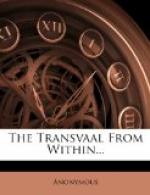On January 5, 1857, the Representative Assembly appointed Mr. Martinus Wessels Pretorius President, and also appointed members of an Executive Council. The oaths of office were then taken, the President and Executive installed, and the flag hoisted. When intelligence of these proceedings reached Zoutpansberg and Lydenburg, there was a violent outburst of indignation. At a public meeting at Zoutpansberg the acts and resolutions of the Representative Assembly at Potchefstroom were almost unanimously repudiated, and a manifesto disowning the new Constitution and everything connected with it was drawn up. Mr. Pretorius then issued a proclamation, deposing Commandant-General Schoeman from all authority, declaring Zoutpansberg in a state of blockade, and prohibiting traders from supplying ‘the rebels’ with ammunition or anything else. This conduct on the part of the new Government under Mr. Pretorius appears to me distinctly adroit. Having taken upon themselves to remodel the entire Constitution of the country, they turn round on the adherents of the older Government, whom, by-the-by, they had not thought it worth while to consult, and promptly call them ‘rebels.’ And so you have this striking political phenomenon of a revolutionary party turning on the adherents of the Government of the State, and denouncing them, forsooth, as ‘rebels.’
The ‘Republic of Lydenburg’ then declared itself into a sovereign and independent State. And thus two Republics, two Volksraads, two Governments, were formed and existed simultaneously in the Transvaal. And all this without a shot being fired, each party finding sufficient relief to its feelings by calling the other party ‘rebels.’ In order to strengthen its position, the party of Pretorius now determined on a bold stroke. They sent emissaries to endeavour to arrange for union with the Free State. The Free State Government rejected their overtures, but Pretorius was led to believe that so many of the Free State burghers were anxious for this union that all that was necessary for him to do, in order to effect it, was to march in with an armed force. He therefore placed himself at the head of a commando, and crossed the Vaal, where he was joined by a certain number of Free State burghers.
But Pretorius, with whom was Paul Kruger, found, like Dr. Jameson, that he had reckoned without his host. When intelligence of this invasion reached Bloemfontein, President Boshoff issued a proclamation declaring martial law in force throughout the Free State, and calling out burghers for the defence of the country. It soon appeared that the majority of the people were ready to support the President, and from all quarters men repaired to Kroonstad. At this stage the Free State President received an offer of assistance from General Schoeman, of Zoutpansberg, against Pretorius, in which object he believed Lydenburg would also join.
On May 25 the two commandoes were drawn up facing each other on opposite banks of the Rhenoster River, and remained in that position for three hours. Threatened from the north as well as the south Pretorius felt his chance of success was small, and he therefore sent out Commandant Paul Kruger with a flag of truce to propose that a pacific settlement should be made.




